Papers in the Biological Sciences

Jay F. Storz Publications
Document Type
Article
Date of this Version
May 2005
Abstract
Two recent studies of wild bird populations provide new insights into mechanisms of microevolutionary change by revealing how variation in fitness-related traits may be maintained over very small spatial scales.
When a population is distributed across a heterogeneous environment, the prospects for local adaptation depend on the spatial scale of fitness variation relative to the spatial scale of dispersal. If the patchiness of environmental conditions is too “fine-grained,” the spatial acuity of natural selection may be severely diminished by the homogenizing effects of gene flow (García-Ramos and Kirkpatrick, 1997; Lenormand, 2002). For example, habitat variation over a scale of several square kilometers may be sufficiently “coarse-grained” to permit local adaptation in animals with weak dispersal capabilities like snails, but certainly not in more vagile animals like birds. So when fine-scale patterns of trait differentiation are observed in high gene flow species, some form of ecological or evolutionary explanation is required.


Comments
Published in Heredity 95 (2005), pp. 3–4; doi:10.1038/sj.hdy.6800683. Copyright © 2005 Nature Publishing Group. Used by permission.